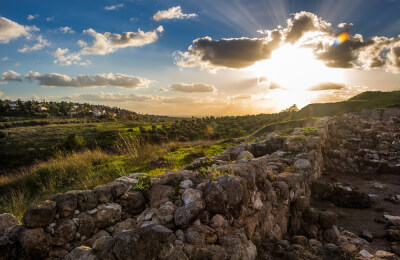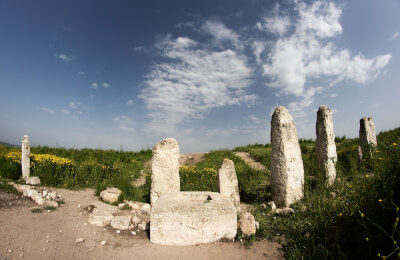 175₪
175₪
 175₪
175₪
We also found excursions from other cities that are close to your departure city
Other excursions that also deserve your attention
to Tel Azeka
Tel Azeka, situated in the heart of Israel's Shephelah (the Judean lowlands), offers a unique vantage point not only to the rolling hills and verdant valleys of the region but also to the layers of ancient civilizations buried within its bounds. This archaeological mound has a storied past that encompasses several millennia and is particularly known for its mention in the biblical narrative as the backdrop for the epic confrontation between David and Goliath.
The Historical Context of Tel Azeka
As one traverses the ancient landscape of Israel, Tel Azeka emerges as a sentinel overlooking the Elah Valley. Historically, it has been a strategically vital location, acting as a buffer between the coastal cities and the hill country of Judea. The city-state that once stood here played a pivotal role in the regional geopolitics, serving as a fortified city in the Kingdom of Judah and experiencing firsthand the tumult of empires clashing over control of the Levant.
The Biblical Tale of David and Goliath
Tel Azeka is most famously associated with the biblical account of David and Goliath. According to the Bible, the Philistines camped between Socoh and Azekah, in Ephes Dammim, and it was in the Valley of Elah where David felled the giant Goliath with a stone from his sling. This dramatic event has fixed Tel Azeka in the collective memory of Judaism, Christianity, and indeed, the world's cultural heritage.
Archaeological Discoveries at Tel Azeka
Excavations at Tel Azeka have revealed a wealth of archaeological treasures spanning numerous periods, from the Canaanite through the Israelite, and into the Hellenistic and Byzantine eras. The findings include fortifications, water systems, administrative buildings, and domestic structures that speak volumes about the everyday lives of its ancient inhabitants. Pottery shards, tools, and inscriptions contribute to a more comprehensive understanding of the social and economic fabric of the time.
The Fortifications of Tel Azeka
Among the archaeological finds, the fortification system of Tel Azeka stands out. It includes massive walls and gates that bear silent testimony to the city's strategic importance and the need for defense against invading armies. These fortifications have been carefully studied to understand better military architecture and warfare tactics in the ancient Near East.
The Water System of Tel Azeka
A remarkable engineering feat discovered at Tel Azeka is its sophisticated water system, designed to ensure a steady water supply even during prolonged sieges. The water system's resilience and ingenuity reflect the advanced understanding of hydraulics and urban planning by the city's ancient engineers.
The Daily Life in Ancient Azeka
Beyond the grandeur of battles and city walls, Tel Azeka provides precious insight into the daily life of its past residents. The remains of houses, cooking utensils, and personal items recreate a picture of domestic life, trade, and the cultural practices that characterized the community.
The LMLK Seals
An intriguing discovery at Tel Azeka is the LMLK seals. These small stamped handles of storage jars have been found throughout Judah, including Azeka, and are thought to be related to the administrative system during the reign of King Hezekiah. These seals are a subject of intense scholarly debate, with theories regarding their purpose ranging from royal administrative marks to symbols of protection.
Visiting Tel Azeka Today
Today, Tel Azeka is not just an archaeological site but a vibrant location for visitors who wish to connect with Israel's deep historical roots. It offers educational tours, hiking trails, and a chance to participate in archaeological digs, making history come alive in a very tangible way.
The Flora and Fauna around Tel Azeka
The natural surroundings of Tel Azeka are as compelling as its archaeology. The site is nestled within a landscape that supports diverse flora and fauna, characteristic of the Mediterranean woodlands. Seasonal wildflowers, birds, and other wildlife add to the richness of the area, providing an additional layer of enjoyment for visitors.
Preservation and Conservation at Tel Azeka
Ongoing efforts to preserve Tel Azeka are vital for maintaining its archaeological integrity and educational value. Conservation initiatives aim to protect the site from natural degradation and the impact of tourism, ensuring that future generations can continue to learn from and be inspired by this window into the ancient past.
Conclusion: The Legacy of Tel Azeka
Tel Azeka's legacy is multifaceted. It is a site of historical confrontation and cultural synthesis, where stories of faith, struggle, and human endeavor intersect. As an enduring piece of Israel's rich tapestry, Tel Azeka serves not just as a relic of the past but as a living classroom, where the landscape of history continues to inform and enlighten those who walk its ancient paths. With each stone turned by archaeologists, the stories buried within the tel reveal more about the complex civilizations that once thrived in this land, making Tel Azeka a must-visit for anyone interested in the origins of Western history and civilization.



